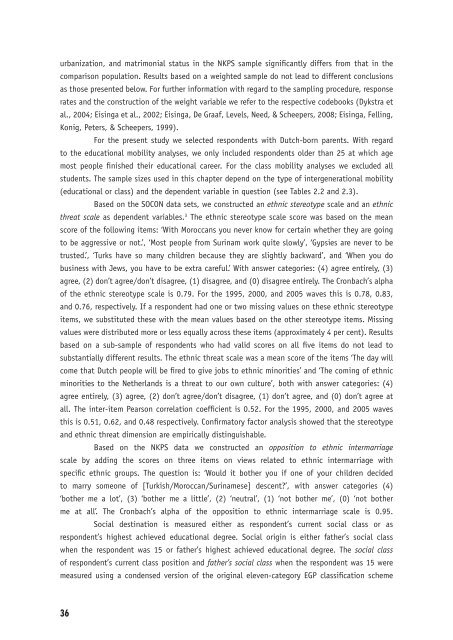Ethnic Hostility among Ethnic Majority and Minority Groups
Ethnic Hostility among Ethnic Majority and Minority Groups
Ethnic Hostility among Ethnic Majority and Minority Groups
Create successful ePaper yourself
Turn your PDF publications into a flip-book with our unique Google optimized e-Paper software.
urbanization, <strong>and</strong> matrimonial status in the NKPS sample signifi cantly differs from that in the<br />
comparison population. Results based on a weighted sample do not lead to different conclusions<br />
as those presented below. For further information with regard to the sampling procedure, response<br />
rates <strong>and</strong> the construction of the weight variable we refer to the respective codebooks (Dykstra et<br />
al., 2004; Eisinga et al., 2002; Eisinga, De Graaf, Levels, Need, & Scheepers, 2008; Eisinga, Felling,<br />
Konig, Peters, & Scheepers, 1999).<br />
For the present study we selected respondents with Dutch-born parents. With regard<br />
to the educational mobility analyses, we only included respondents older than 25 at which age<br />
most people fi nished their educational career. For the class mobility analyses we excluded all<br />
students. The sample sizes used in this chapter depend on the type of intergenerational mobility<br />
(educational or class) <strong>and</strong> the dependent variable in question (see Tables 2.2 <strong>and</strong> 2.3).<br />
Based on the SOCON data sets, we constructed an ethnic stereotype scale <strong>and</strong> an ethnic<br />
threat scale as dependent variables. 3 The ethnic stereotype scale score was based on the mean<br />
score of the following items: ‘With Moroccans you never know for certain whether they are going<br />
to be aggressive or not.’, ‘Most people from Surinam work quite slowly’, ‘Gypsies are never to be<br />
trusted.’, ‘Turks have so many children because they are slightly backward’, <strong>and</strong> ‘When you do<br />
business with Jews, you have to be extra careful.’ With answer categories: (4) agree entirely, (3)<br />
agree, (2) don’t agree/don’t disagree, (1) disagree, <strong>and</strong> (0) disagree entirely. The Cronbach’s alpha<br />
of the ethnic stereotype scale is 0.79. For the 1995, 2000, <strong>and</strong> 2005 waves this is 0.78, 0.83,<br />
<strong>and</strong> 0.76, respectively. If a respondent had one or two missing values on these ethnic stereotype<br />
items, we substituted these with the mean values based on the other stereotype items. Missing<br />
values were distributed more or less equally across these items (approximately 4 per cent). Results<br />
based on a sub-sample of respondents who had valid scores on all fi ve items do not lead to<br />
substantially different results. The ethnic threat scale was a mean score of the items ‘The day will<br />
come that Dutch people will be fi red to give jobs to ethnic minorities’ <strong>and</strong> ‘The coming of ethnic<br />
minorities to the Netherl<strong>and</strong>s is a threat to our own culture’, both with answer categories: (4)<br />
agree entirely, (3) agree, (2) don’t agree/don’t disagree, (1) don’t agree, <strong>and</strong> (0) don’t agree at<br />
all. The inter-item Pearson correlation coeffi cient is 0.52. For the 1995, 2000, <strong>and</strong> 2005 waves<br />
this is 0.51, 0.62, <strong>and</strong> 0.48 respectively. Confi rmatory factor analysis showed that the stereotype<br />
<strong>and</strong> ethnic threat dimension are empirically distinguishable.<br />
Based on the NKPS data we constructed an opposition to ethnic intermarriage<br />
scale by adding the scores on three items on views related to ethnic intermarriage with<br />
specifi c ethnic groups. The question is: ‘Would it bother you if one of your children decided<br />
to marry someone of [Turkish/Moroccan/Surinamese] descent?’, with answer categories (4)<br />
‘bother me a lot’, (3) ‘bother me a little’, (2) ‘neutral’, (1) ‘not bother me’, (0) ‘not bother<br />
me at all’. The Cronbach’s alpha of the opposition to ethnic intermarriage scale is 0.95.<br />
Social destination is measured either as respondent’s current social class or as<br />
respondent’s highest achieved educational degree. Social origin is either father’s social class<br />
when the respondent was 15 or father’s highest achieved educational degree. The social class<br />
of respondent’s current class position <strong>and</strong> father’s social class when the respondent was 15 were<br />
measured using a condensed version of the original eleven-category EGP classifi cation scheme<br />
36












